Shopping for Fashions & Accessories 1912
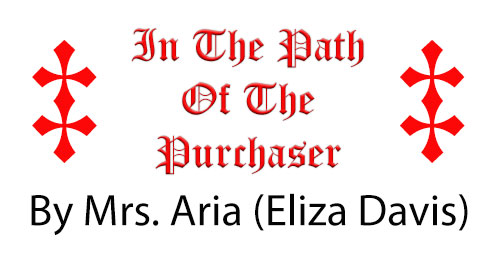
Shopping in London was a lot easier in 1912 with this synopsis of some of the more exquisite shops along with description of their specialty items. The Cunard Line created this annual report for publication in their magazine, the Cunard Daily Bulletin.
Dr. Jaeger Hygienic Clothing
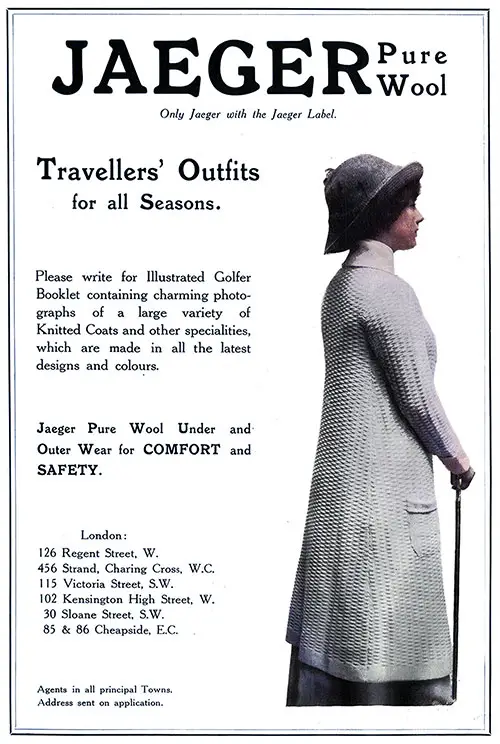
There are few now-a-days who do not wear woolen undergarments, and consequently few who do not know —and doubtless bless—the name of Dr. Jaeger, and associate everything connected with the world-famous apostle of hygienic wear with perfection of workmanship and the purest of materials.
A visit to the head establishment at 126, Regent Street, London, W., is sure to be included in the program of our American cousins, and so for their benefit we should like to give attention to some of the novelties for the season.
Among these are the knitted travelling toques in various colors, with a brim which can be turned up to suit the face and decorated with a knitted mount to match. Smart knitted coats with roll or sweater collars are supplied to go with them, and so make an ideal travelling outfit.
Then there are the knitted Cardigan jackets in Eastern wool, in which bright colors seem to be the prevailing fancy—such as purple, tomato red, and orange, whilst the jackets, which are among the novelties for this season.
Knitted in loose Shetland stitch in the softest and lightest of wool—with borders closely-knitted in garter-stitch, are exquisitely light, soft, and cozy, as they cling so closely to the wrist and figure. These can be had in shot effects, one color over another, in coat or blouse length, and are delightful to wear„. alone, or under a motoring wrap.
For steamer wear there are bath robes in beautiful weaves of camel-hair cloth, suited to all temperatures, a special light make being used for summer wraps, and these, it need not be said, are an essential part of the outfit.
Many members of the fair sex, when travelling, add to their outfit plain pajama suits, which the firm of Jaeger manufacture in the finest of wool delaine in various dainty coloring. Yacht sheets and blankets of the purest wool are also a specialty of the firm.
For travelling, too, their long coats are quite ideal wraps, as they are made in the lightest and softest of reversible woolen fabrics, with a silky surface, suggesting the finest of face cloths.
They belong in design to the sacque order but are so cleverly cut that they are not quite so shapeless as the name suggests. With regard to the other garments, one cannot refrain from mentioning the shirt blouses, in pure wool—striped taffeta—daintily made with pin tuckings, deep pleats, and polo collars, or the pretty delaine blouses embroidered in a wide variety of dainty colorings and designs, which will “go” with any costume.
The underwear and hosiery, and the perfectly fitting corsets need no special mention, as they are known to all, but one must not forget to note the charming little knitted tunics and other goods of which Messrs. Jaeger are making a special feature.
These promise to be very popular for seaside wear for little folks, in this country, as they have been for some time abroad, and can be recommended as ideal suits for both boys and girls for seaside wear.
For the boys, knickers are supplied, and skirts for the wee girls, whilst every other possible garment in the purest of wool for small and grown up folk—can be obtained at 126, Regent Street.
Paquin, Ltd. Women’s Fashions – Parisian Modistes
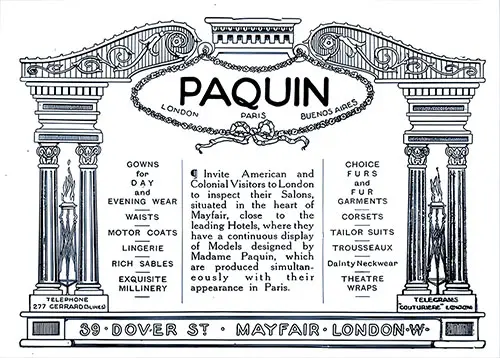
In the realm of dress the firm of Paquin Ltd., stands well to the front, as that of one of the great arbiters of fashion, and American ladies do not need to be urged to pay a visit to this famous house.
They may not know that it is not necessary to go to Paris for the latest fashions, as the creations are produced simultaneously in the two cities. At the beautiful Ateliers at 39, Dover Street, London, they will see just the same sartorial results as they would do in Paris, whilst in the realm of millinery they will find not only the newest and most original designs of this department, but those of all the leading houses in Paris.
It was here that I was recently vouchsafed glimpses of the modes of the present and the future, and I have recollection of a procession of beautiful frocks, all bearing the distinctive “cachet” of the house of Paquin.
The panier was in evidence in evening gown which passed before me, the bodice and draperies of which were of soft apple-green silk, the latter caught with a bunch of shaded roses to fall at one side of the back over the long-pointed train of the white satin under-dress.
The transparency of the upper part of the décolleté bodice was veiled in heavy guipure lace, and a gathered vest-piece of “vieux rose” satin gave a pretty touch of color to the bodice.
My mind’s eye also conjures up visions of a white satin gown of Egyptian design, with a swathed chiffon sash; a lovely tea- gown, of cream lace over canary yellow satin, the skirt bordered with three widely-spaced tucks, each one edged with a fringe of single beads.
A “visite” of coppery-red taffetas with a shell-like old-world trimming of the silk round the edge, and a heavily embroidered écru collar; a smart tailor-made—for which gown Paquin is famous—of navy and white striped serge.
The V-shaped openings of the coat filled in with horizontal arrangements of the stripes, also those between the wide rounded panels of the back and front of the skirt; of an original gown in which taffeta and cloth were allied, the skirt front being of the former, whilst the back of the latter was rounded off from the waist panier-wise.
Last but not least, a charming indoor dress suggesting the master touch of M. Paul Iribe, composed of bordered navy foulard dotted with white pin spots, where the skirt was finely pleated from hem to waist, without interfering with its slim outlines, whilst a wide jabot of Broderie Richelieu, adorned the front of the smart coatee-like bodice.
These are but a few of the lovely gowns to be seen at the house of Paquin, 39, Dover Street, where I must not forget to say that special attention is being given to blouses and lingerie, and to the special corset for which the house is so famous.
Furs of the finest quality can be obtained here, the firm being in touch with the leading furriers and dealers all over the world.
Scotch tweeds and hand-woven fabrics have a reputation all the world over, and where “sports” and travelling garb are concerned, a costume or garment, fashioned of one or other of the North British fabrics, are an absolute necessity, as nothing else possesses the same durability, lightness, and rain-proof quality.
MacDougall & Co., Scottish Clothier
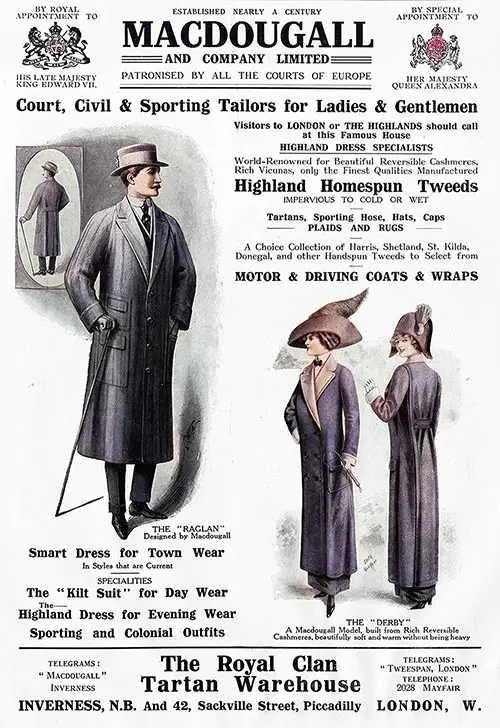
The sportsman, whether he be prepared for slaughter in Auld Reekie, or the Rockies, or any other part of the world, can be sure of being suited with an outfit made of the best of these fabrics at Messrs. MacDougall & Co., of 42, Sackville Street, London, and Strathpeffer, Scotland.
The cut, finish, and style of every garment emanating from the well- known firm are irreproachable, as is proved by the patronage extended to them by their present Majesties, King George and Queen Mary.
Here are to be obtained the real hand-made Scotch homespun, also Shetland, Sutherland, St. Kilda, and the famous Harris tweeds, which last have gained the encomiums of Lord Rosebery, amongst others. It may be noted that this tweed can be had in charming colorings, such as Saxe blue.
Reversible cashmeres, which are not only the “real thing,” but are also beautifully smooth and light, are some of them more suited to evening than to day wear.
Though Scottish tweeds are mostly associated with masculine garb—of the sporting order—and have, therefore, been mentioned first, Messrs. MacDougall have for some time past been noted for the cut and finish of their costumes intended for the other sex.
They are now making a highly successful bid for favor in the realm of ladies’ tailoring, not only in tweed and cloth costumes but in the more decorative materials which are now being pressed into service.
One such gown I was shown, of navy blue silk whip-cord, which was eminently smart and well cut; and the same remark applies to another of white hopsack, trimmed with a collar of vivid green éponge and embroidery in Oriental style, with a finish of cords and glass buttons.
For ladies, the firm is now making a specialty of knitted silk coats, hoods, and hats en suite, also travelling coats and rugs, Angora scarves and hoods, and sporting and travelling hats of every description, in tweed, velvet and leather.
Lastly, it may be well to point out that Messrs. MacDougall are the makers of the celebrated “Cawdor” and “Lothian” capes, indispensable for deer-stalking, and that every- thing in the way of knitted, or woven, Scottish hosiery and materials can be obtained at 42, Sackville Street.
Inglis & Tinckler (Irish Warehouse) Fine Irish Linens
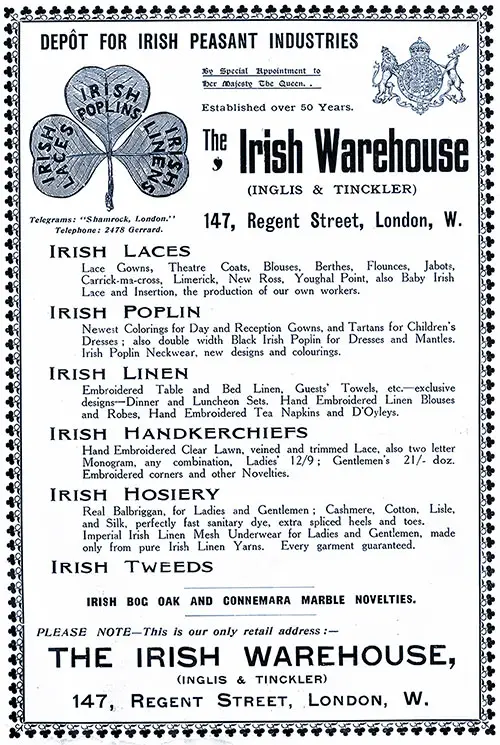
At Messrs. Inglis & Tinckler, 147, Regent Street, London, W., can be seen in perfection the beautiful work, the fine linen, and lace for which the Irish peasantry are famous all the world over, and which appeal so strongly to our American cousins, who so greatly admire dainty hand-work.
At this old established firm they will find the most lovely bed spreads, hand-embroidered; blouses fashioned of the most exquisite linen; over blouses and jackets of Irish crochet.
The blouse lengths, unmade and daintily embroidered, would make most inexpensive and acceptable gifts when returning home. And apropos of presents I should like to draw attention to the lunch and tea set, which are amongst the season’s novelties, and which consist of twenty-five pieces, worked in broderie Anglaise, on fine linen, in a great variety of styles and prices.
Also the hand-embroidered tea doyleys, for which this firm has become noted; lastly, the perfectly charming little handkerchief sachets in white linen, beautifully hand-embroidered, which are ideal for travelling purposes.
Another novelty, of which Messrs. Inglis & Tinckler are making a special feature, are the linen handkerchiefs embroidered with a monogram in the corner.
As every possible combination of two letters is kept in stock, —the list running into many hundreds— there is no fear of not finding the monogram required, and no need to wait for it to be worked.
The dainty little embroidered linen baby cushions, which are so delightful an addition to the travelling outfit, are specialties of the firm which we need only refer to as they are so much appreciated and patronized by American “voyageuses.”
In the way of the laces for which Ireland is noted, Messrs. Inglis and Tinckler keep a beautiful and varied choice, of every kind, in crochet, as well as Carrickmacross, Limerick, and the more costly Irish-mac-Saint, Youghal Point, and the exquisite new Hoss Point, the last a needlepoint lace of the kind to be handed down among one’s most treasured possessions, a wide flounce of which can be had for only £10 a yard.
Of lace handkerchiefs it need hardly be mentioned that they have a wide selection bordered with every kind of Irish lace, but one must not forget to say that the “mere man” is not forgotten by the firm, who make a specialty of providing him with a wonderful choice of ties in Irish poplin (a range of 150 colorings being kept in stock) as well as linen handkerchiefs in every quality.
In the way of table linens, too, the real Irish satin damask can be supplied to those who prefer this to the more ornate tablecloths, lace-trimmed and embroidered.
J. C. Vickery: Jeweler, Silversmith, and Leather Goods Manufactures
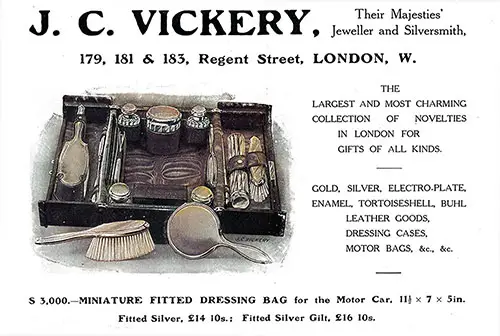
It is always somewhat difficult to select a wedding or birthday gift for the “mere man,” but at Messrs. J. C. Vickery, 179 to 183, Regent Street, one is sure of finding something that will meet with his favor and acceptance.
The flat detachable knives, for instance, in sheaths, gold, silver or jeweled, which are such an ornament to the watch-chain, are sure to be appreciated. Still more acceptable, perhaps, are the gold and silver cases for the waistcoat pocket, which contain pen- knife, pencil, and toothpick, and in some cases a cigar-cutter—which cases are now so extremely popular—because they are both useful and ornamental.
Then there are measure rulers, perpetual calendars, everything in the way of smokers’ requisites, solid silver cigar and cigarette boxes, folding thermometers, and a host of other things, which one is quite safe in offering to the “mere man,” whether relative, fiancé, or husband.
Though I have given place to the “lords of creation,” it is mainly because, where presents are concerned, they are usually so difficult to please, but at the firm mentioned, you will find a large assortment of articles for my lady’s wear, in the way of bridal offerings, also gifts for wedding, birthday and every other anniversary.
Here you will find everything for the purpose, from the daintiest of lucky charms to the most useful piece of plate and complete sets of table appointments and cutlery canteens, from a plain safety-pin to most beautiful jeweled chains, pendants and plaques—which, by the way are made with sets of interchangeable enamel backs, — also earrings, with sets of different drops, so that the ornaments can be changed to match the dress.
The flexible gold wrist snake chain for suspending the vanity-bag, purse, and the other articles we pocketless women are condemned to carry, are sure to be appreciated, likewise the gold corsage bouquet holders which can be obtained both plain and jeweled.
Here, too, will be found a magnificent collection of plain and ornamental tortoise-shell writing- table and toilet appointments, which make such lovely wedding presents.
Mention, too, must be made of the fact that their special novelties for the coming season are ornaments and writing sets in New Zealand green jade, the stone which is supposed to carry good- luck and is therefore assured of popularity.
Messrs. J. C. Vickery, it may be added, have special sealed warrants of appointment to His Majesty King George V. and Queen Mary, Queen Alexandra, and nearly all the crowned heads of Europe. They are also specialists in the manufacture of dressing- bags, which they supply to the Royal Family.
There is a charm about old English silver, particularly of the eighteenth century, which the modern variety does not always possess, beautiful though this may be.
But the silver which possesses this charm in the greatest degree—and is, perhaps, the most beautiful of table decoration possible—is that which belongs to the “pretty” period of the Georgian era, that is, from about 1760 to 1780, when designs were light and pierced.
Spink & Son, Ltd. Numismatists & Medalist
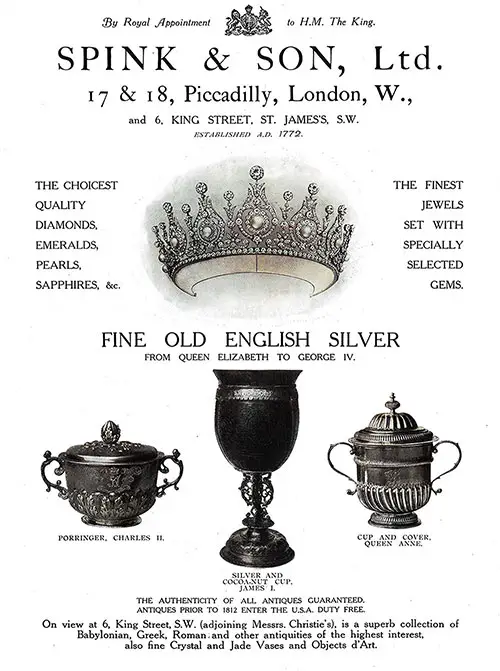
You will find a very large selection of this kind of silver at Messrs. Spink and Son, Ltd., of 17, Piccadilly, W., who for years past have made a specialty of this—as well as other kinds of old English silver, — and have one of the finest collections in London of old plate of every kind. It would of course be impossible to do more than refer to a few of the most noteworthy things to be found here, which were shown me during a recent visit.
Among these a silver bon-bon dish, with a wide-open border, over which a raised floral pattern trailed gracefully, first claimed my admiration, both for its lightness of design and the beauty of its workmanship, and I also paid tribute to the artist-silversmith who had fashioned it with such loving care.
Then I noticed some beautiful specimens of table silver of the pierced Georgian type above referred to; which is so much to be preferred to the somewhat heavier designs which followed it towards the end of the eighteenth century and culminated with the last of the four Georges.
Particularly beautiful, and graceful too, were some solid silver candlesticks, I noticed, whilst a very fine table service of old silver in the possession of Messrs. Spink, must be specially mentioned, which is worthy of the attention of those who are anxious to obtain, not only a particularly handsome service of old plate, but one to which a certain amount of historical interest is attached.
The service in question, which is of heavy silver, was presented to a well-known Spanish general, at the time of the Peninsular War, and includes entrée, breakfast, meat, and other dishes, also salt-cellars, etc., etc.
But the show of old silver, at Messrs. Spink and Son’s, extensive though it is, represents only one portion of their large and varied collection; and, as they have a wonderful selection of jeweled curios, including much beautiful old antique jewelry, which, now that Queen Mary has set the fashion and has shown her preference for this kind of “bijouterie,” are sure to be much sought after.
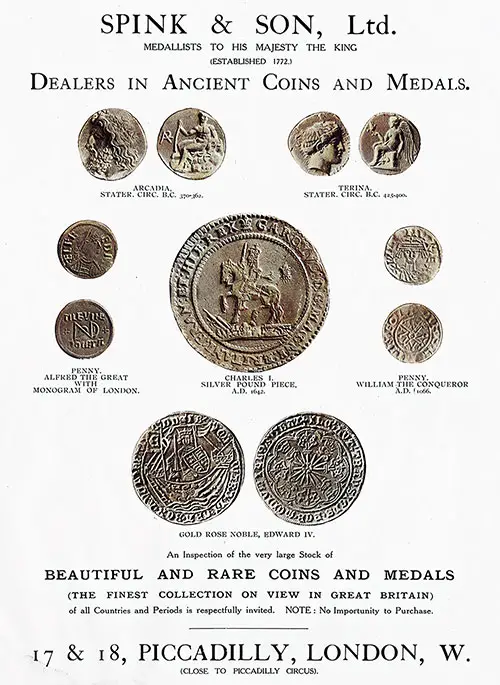
Then, too, collectors of coins will find No. 17, Piccadilly, a very happy hunting- ground. These, at least, for such as are interested in them—will alone repay a visit, especially when it is known that there is no importuning to buy.
E. M. Hodgkins – Works of Art, Drawings, and Pictures
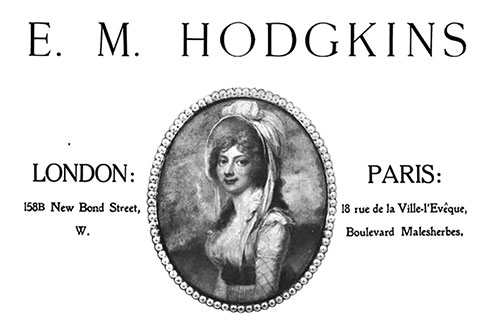
As to the beauty of French furniture— of the best periods—there can be no two opinions, and those Americans, who, like the writer, have a penchant for such “meubles,” should pay a visit to the beautiful “salons” of E. M. Hodgkins, 158b, New Bond Street, London, W.
Here one steps from the noise and bustle of this busy shopping thoroughfare, into the peaceful atmosphere of a beautifully- furnished house, where the choicest examples of French furniture, superb “commodes,” and “armoire,” and tables, meet the eye.
In addition to these treasures there is a wonderful collection of English miniatures, by Cosway, and other noted masters of this most fascinating art, over which one would love to linger, as well as the fine collection of original drawings by Reynolds, and other English portraitists of this period, were it not that it is as specialists in French furniture that the firm of E. M. Hodgkins prefer to be known and on which they have built up so great a reputation.
Paris House – Purveyors of Fine Porcelain, Furniture, and Other Distinctive Gifts
At the Paris house, in the Rue de la Ville L'evêque 18, will be found some of their choicest treasures, such as a collection of Sévres porcelain, which is said by connoisseurs to be next to that at the Wallace Museum the very finest outside any private collection in Europe. This was exhibited at the Louvre in 1909.
A superb collection of Régence furniture, also compels our admiration, including as it does, “armoires,” the cabinet work of which reveals the master hand of Crescent, the ormolu mountings that of Cafheri, which came from the collection of Count Boni de Castellane.
In the Rue de la Ville Fevéque, too, is a beautiful show of Oriental porcelain, ornamented with “Boucher” subjects, also three exceptionally fine panels of Beauvais tapestry, the subjects representing “The Temple and the Toilet of Venus,” and the “Abandonment of Venus.”
Equally interesting is the interior of the music-room which was taken from the house of Mirabeau at Grasse, and belonged to his sister, Madame la Marquise de Cabris. The ceiling was decorated by Fragonard, the artist who did so much for the notorious du Barry.
One must not omit to draw attention to the portrait, in Paris, of Miss Harris by Sir Joshua Reynolds, considered to be one of the most charming child portraits ever painted by that master.
These are but a very few of the treasures to be seen in the “salons” of the firm of E. M. Hodgkins. The increasing calls upon the firm have made it necessary to open a branch in the New World, at 630, Fifth Avenue, New York, where clients are cordially welcomed.
Our cousins—of both sexes—from across the “Herring Pond,” have of late years shewn such a marked fancy for good English furniture and bric-a-brac.
A. B. Daniell
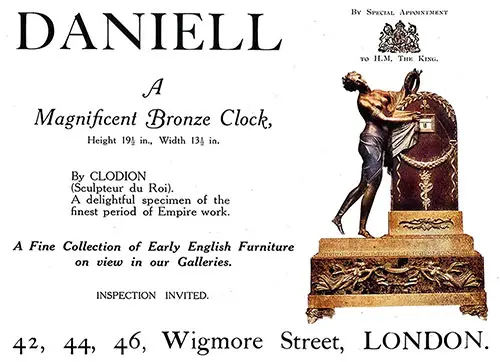
Those who are on furnishing intent during their visit to Europe, may be glad to know—or perhaps to be only reminded—that at Messrs. A. & B. Daniell, 44, Wigmore Street, W., they will find a choice selection not only of furniture, but of rare china, including some very old Lowestoft ware, and articles of “bigotry and virtue,” as Mrs. Brown might, or perhaps did, say.
Wigmore Street is parallel to, and just behind, Oxford Street, so is easily accessible, and Messrs. Daniel’s galleries have for nearly one hundred years exhibited the finest examples of the work of the cabinet makers of the eighteenth century.
Old Chippendale and Old Sheraton, though furniture of other periods will also be found here, whilst the decoration of rooms in old oak paneling are most successfully undertaken by the firm.
In this connection we might particularly mention the beautiful paneling and mantel-piece of the time of Queen Elizabeth, brought from an old house in Oulton Broad, which they have on view.
It might also be added that they are always pleased to give clients the benefit of their long experience in decorative matters and prepare estimates free of cost.
Goldsmiths & Silversmiths Company, Wedding Presents, Presentation Plate, Etc.
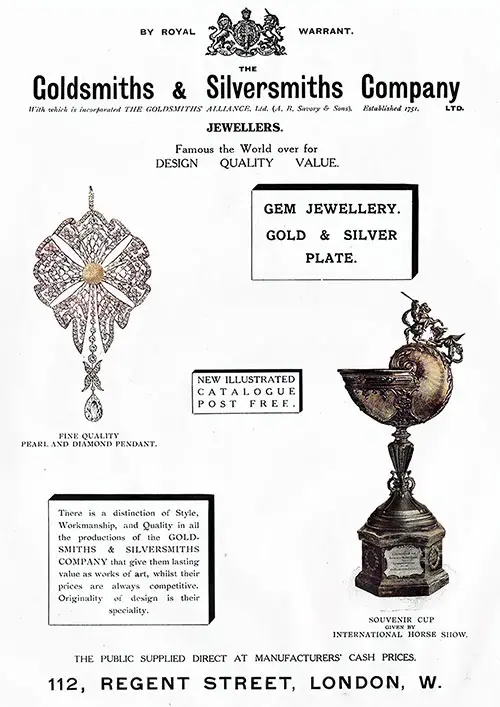
"Tis plate of rare de vice, and jewels of rich and exquisite form; their value’s great.” Thus wrote the immortal bard some three hundred years ago, and yet the words are curiously applicable to the treasures in the show rooms of the Goldsmiths’ and Silversmiths’ Company Ltd., of 112, Regent Street.
Here is a wonderful collection of plate of “rare de vice,” both in gold and silver, and here are jewels whose value is more nearly priceless than “great,” but of whose “exquisite form” there is no manner of doubt.
But, as in everything else, fashion influences jewelry, and of late years in particular, changes are constantly being made in the settings and designs as well as the form and cutting of the stones themselves.
But at the Goldsmiths’ and Silversmiths’ Company, Ltd., one is sure, not only of seeing the most perfect stones procurable —only flawless gems being used—but the very latest modes combined with the most perfect workmanship, the last by no means an unimportant detail where jewelry is concerned.
A recent visit to the showrooms revealed to me, amongst many things, the fact that there is a return to favor of some of the semi-precious stones, such as tourmalines, and aqua-marines, the delicate, translucent blue of the latter stone making a lovely center to, and foil for, the diamonds with which it was surrounded.
In the way of diamond cutting, the present fancy seems to turn to the elliptical shape—occasionally the Brilliolette for diamond pendants, and square-cut stones for rings, beautiful specimens of both of which gems were shown me, as well as a wonderful and dazzling collection of diamond plaques and pendants, hair-ornaments and tiaras.
Among these a small coronet of purely Grecian design stands out in my memory, by reason of the grace and charm of its setting, and the perfect gems used, though its companions were each lovely in a different way.
With regard to chains, some were remarkably beautiful, one in particular being composed of flat and oblong links, each set with tiny diamonds, whilst a rivière shown me was of exceptional beauty, consisting of single diamonds, united by little bows set with tiny stones.
For a diamond set shown me, however, words fail me to describe the exquisite beauty of the stones and the ring in particular, this last being valued at £1,100!
It was composed of one large and flawless diamond, whilst the raised scroll setting, which held the magnificent stone, as well as the ring portion, was closely set with wee diamonds and represented a perfect triumph of the jeweler’s art. The corsage ornament was set with pear-shaped drops, and with the brooch and the ring mentioned, formed a set of wonderful beauty.
Earrings, too, are again in fashion, and of these the Goldsmiths’ and Silversmiths’ Company, Ltd., 112, Regent Street, London, have a bewildering array in pearls, and of the diamond pendant order, whilst where rings are concerned, they hold the largest stock in London.
With regard to pearls, a beautiful collection of these gems of the Orient are to be seen.
It may be pointed out that everything is marked in plain figures, and that the beautiful collection at 112, Regent Street is always open to the inspection of visitors, to whom the Company extend a cordial welcome.
Grafton Hotel in London
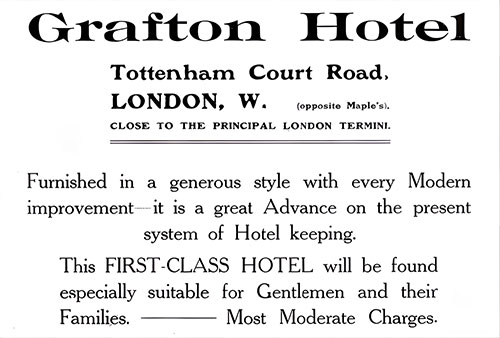
Within the past decade or so, there has been an ever-increasing demand for hotels combining comfort with economy, and both of these essentials will be met with at the Grafton Hotel, Tottenham Court Road, London, which is conveniently situated for those who are on “pleasure bent” as well as the business man.
It is within an eight-penny taxicab ride of the great London termini of Euston, St. Pancras and King’s Cross, and one shilling will convey the visitor to Marylebone, Paddington or Charing Cross Stations. Euston Square Station (formerly known as Gower Street) is within two minutes’ walk.
Whence all City Stations are reached in fifteen minutes, and there is a “Tube” Station opposite the Hotel, from which Charing Cross can be reached in five minutes at the cost of one penny. Frequent Services of ’buses pass the door for all parts of London.
The Hotel, as well as its interior decorations and furniture, is quite new. Messrs. Maple and Co. have had charge of the latter and have struck the keynote of elegance and comfort in the public and private rooms, and no fewer than thirty-six bath-rooms have been provided.
The bedroom, bath, lights, full table d’hôtel breakfast and attendance can be had from 5s. to 7s. 6d., and inclusive terms from three guineas weekly can be arranged for a lengthened stay.
Hunt and Roskell / J. W. Benson, Ltd. - Jewelers
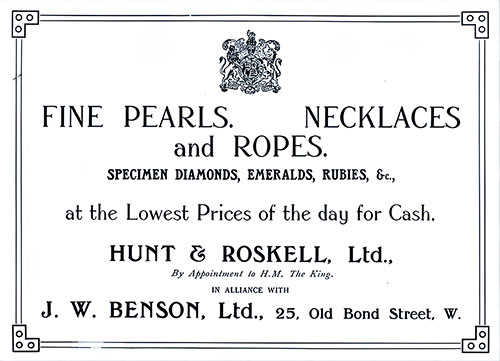
The jewelry house of Messrs. Hunt and Roskell is now carried on in alliance with Messrs. J. W. Benson, Ltd., at 25, Old Bond Street, London, and the combined stocks of these two well-known houses may be said to embrace one of the finest shows in London.
The diamond work, with stones of extraordinary purity, has always been famous at this establishment.
Beautiful specimens of pearl work, neck- laces and ropes, are a specialty at 25, Old Bond Street, not to mention the many choice designs in brooches, pendants, and rings, set with diamonds, emeralds, rubies and sapphires.
Many of these are in the new platinum settings, giving a lightness and beauty not obtainable in the usual gold work. Of special interest also to American visitors is Messrs. Hunt and Roskell’s collection of rare old English silverware.
M. Konski – Furrier, Dressmaker, and Ladies’ Tailor
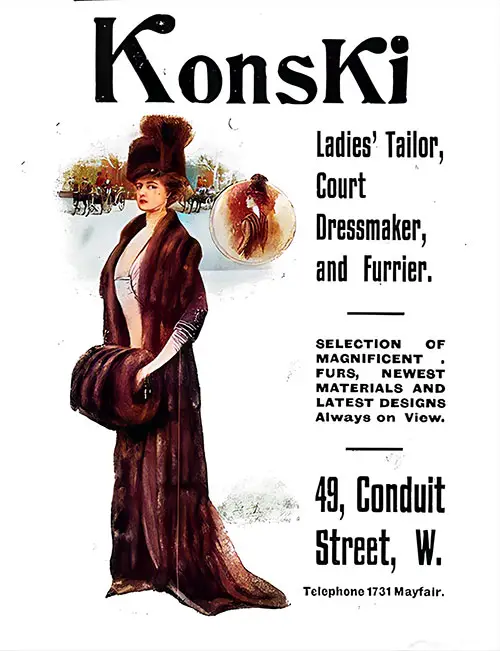
The woman who values correctness of style should pay a visit to Konski’s Showrooms, 49, Conduit Street, W., where all the newest modes for summer and early autumn wear are now to be seen.
The name of this firm is so intimately associated with furs that visitors expect to find peltry of the very best in Konski’s Salons, and they are never disappointed.
The models, as well as the manipulation of the different furs, are as near perfection as it is possible to achieve, and the prices are most moderate, particularly at this time of the year.
Though the name of Konski is usually associated with furs, it may be pointed out that few artists are capable of designing gowns and coats more elegant and up-to-date, and at the same time suited to the wearer’s individuality.
Lacon & Ollier's Opera and Theatre Agency
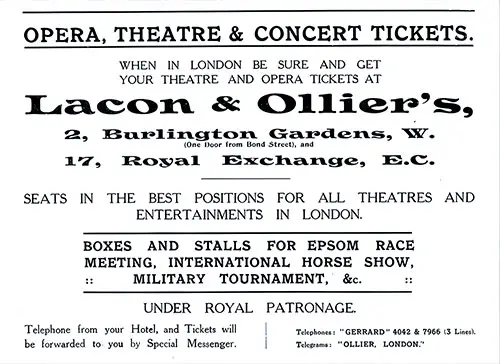
When in London theatre and opera tickets can be secured at Lacon & Ollier's Opera and Theatre Agency, 2, Burlington Gardens, W. (one door from Bond Street), and 17, Royal Exchange, E.C. Seats may be obtained in the best positions for all theatres and entertainments in London, in fact every important social event. A telephone message from your hotel and tickets will be forwarded by special messenger.
Turner Lord & Co – Exquisite Furnishings and Decorative Work
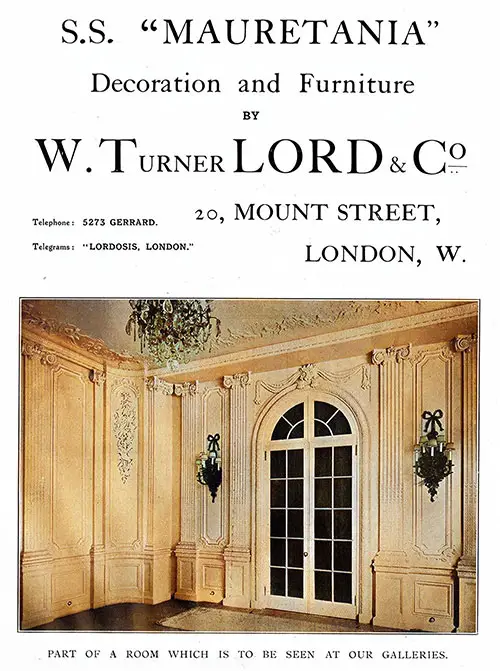
The name of Turner Lord & Co., of 20, Mount Street, Grosvenor Square, London, W., specialists in matters artistic and decorative, must be well-known to many of our readers, for they carried out much beautiful decoration and furnishing of the “Mauretania.”
The fitting-up of this famous vessel, however, represents but one of their many triumphs of decorative work, as a visit to the showrooms in Mount Street will amply testify.
There one finds models, perfect in every detail, of the various schemes of most elaborate internal decorations, which have been success- fully carried out for many leaders of society by Messrs. Turner Lord & Co. Indeed, one could spend an hour or two examining these models of “Wren” and other rooms, as well as those fitted up in “Adam” style, and the beautiful reproduction of a “William and Mary” room at Hampton Court.
The brocades, tapestries, etc., used here are, in the majority of cases, reproductions of famous old pieces, so that the furnishing is all in keeping with the period in which the decorative work is being carried out.
These fabrics are woven specially for Messrs. Turner Lord & Co., to their own design, very often for one scheme only, so that clients have the satisfaction of knowing that their hangings and furnishing fabrics will not be found else- where.
One especially interesting invention of the firm is a method of protecting valuable tapestry from damp or fire. It can be removed from the walls at the least sign of danger, without injury.
How much costly old tapestry might have been saved, had this method been known, or employed, it is impossible to say, but it is well that possessors of these treasures of old needlecraft, should be reminded of this invention.
There is, however, nothing in the way of house decoration or restoration that they cannot be consulted about, and also undertake, even to the complete installation of the electric lighting.
They have also a branch house in Edinburgh, trading as Morison & Co., Charlotte Square, a firm dating from the early part of the nineteenth century.
Forbearance
Hast thou named all the birds without a gun,
Loved the wood rose and left it on its stalk,
At rich men’s tables eaten bread and pulse,
Unarmed faced danger with a heart of trust And loved too well a high behavior In man or maid that thou from speech refrained, Nobility more nobly to repay?
Oh, be my friend and teach me to be thine!
—Ralph Waldo Emerson
Terminology
A coatee was a type of tight fitting uniform coat or jacket, which was waist length at the front and had short tails behind. The coatee began to replace the long tail coat in western armies at the end of the eighteenth century but was itself superseded by the tunic in the mid nineteenth century.
Carrickmacross lace is a form of lace that may be described as decorated net. A three-layer 'sandwich' is made consisting of the pattern (at the bottom), covered with, first, machine-made net and then fine muslin, through which the pattern can be seen. A thick outlining thread is stitched down along the lines of the pattern, sewing net and fabric together. Loops of thread known as 'twirls' are also couched along the outer edge. The excess fabric is then cut away. Some of the net is then usually decorated further with needle-run stitches or small button-holed rings known as 'pops'. Occasionally bars of buttonhole stitches are worked over fabric and net before both are cut away.
The Briolette Diamond - one of the fascinating antique diamond cuts.
“In the Path of the Purchaser,” in the Cunard Daily Bulletin: The Leading and Most Influential Atlantic Ocean Daily Newspaper, Liverpool: The Cunard Steam Ship Co. Ltd., Summer Number, 1912, p. 78-89.
